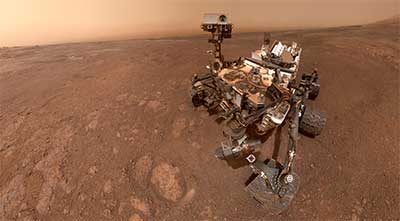NASA’s Curiosity Mars Rover in news
Nasa Curiosity Rover recently provided a pair of panoramas using its Mastcam on March 4, 2021, the 3,049th Martian day of the mission. NASA's Curiosity rover used two cameras to create a selfie in front of "Mont Mercou," a rock formation that stands 20 feet tall. At the start of March, NASA’s Curiosity Mars rover began approaching an impressive rock formation that scientists dubbed “Mont Mercou,” a nickname taken from a mountain in France. Standing about 20 feet (6 meters) tall, the outcrop is captured in all its majesty in a new selfie, as well as in a pair of panoramas that offer a 3D view. The selfie shows Curiosity in front of Mont Mercou with a new drill hole nearby at a rock sample nicknamed “Nontron” – the mission’s 30th sample to date.
France’s Mont Mercou is located near the village of Nontron in the southeast of the country. The team chose Nontron-related nicknames for this part of the Red Planet because Mars orbiters detected nontronite, a type of clay mineral found close to Nontron, in the region. Surface missions assign nicknames to landmarks to provide the mission’s team members a common way to refer to rocks, soils, and other geologic features of interest.
About NASA Curiosity Rover :
Part of NASA's Mars Science Laboratory mission, Curiosity is the largest and most capable rover ever sent to Mars. It was launched on November 26, 2011. It's launch vehicle was Atlas V-451.
Curiosity set out to answer the question: Did Mars ever have the right environmental conditions to support small life forms called microbes? Early in its mission, Curiosity's scientific tools found chemical and mineral evidence of past habitable environments on Mars. It continues to explore the rock record from a time when Mars could have been home to microbial life.
NASA's Curiosity missions objective is to explore Gale Crater and acquires rock, soil, and air samples for onboard analysis.
Gale Crater formed when a meteor hit Mars in its early history, about 3.5 to 3.8 billion years ago. The meteor impact punched a hole in the terrain. The explosion ejected rocks and soil that landed around the crater. Scientists chose Gale Crater as the landing site for Curiosity because it has many signs that water was present over its history. Water is a key ingredient of life as we know it.
The car-size rover is about as tall as a basketball player and uses a 7 foot-long arm to place tools close to rocks selected for study. Curiosity's large size allows it to carry an advanced kit of 10 science instruments. It has tools including 17 cameras, a laser to vaporize and study small pinpoint spots of rocks at a distance, and a drill to collect powdered rock samples. It hunts for special rocks that formed in water and/or have signs of organics.







